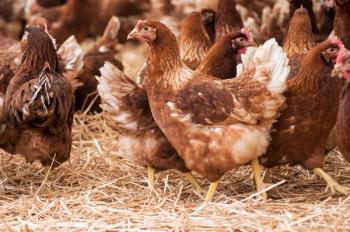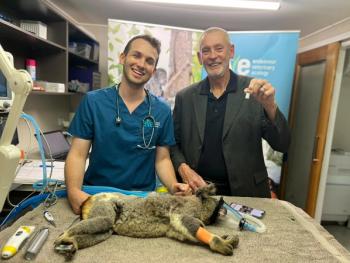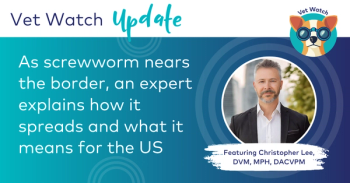
Update on viral enteritis (Proceedings)
Parvoviruses remain a significant enteric pathogen of cats and dogs.
Parvovirus
Parvoviruses remain a significant enteric pathogen of cats and dogs. Parvovirus of dogs is believed to have emerged as a host variant of feline parvovirus, and was designated canine parvovirus-2 (CPV-2). This variant did not infect cats. The virus continued to evolve, and was replaced by CPV-2a and 2b, the latter being the most prevalent currently. The newer variants reacquired the ability to replicate and cause disease in cats. All of these variants are closely related, sharing approximately 99% DNA homology.
Parvoviruses are unique among most DNA viruses in that they have a significant mutation rate, more similar to that of RNA viruses; thus, mutations continue to occur in circulating virus. In recent years, additional variants have emerged, and differ from CPV-2b by just a few amino acid residues, with some leading to antigenic differences. The nomenclature of these variants is confusing, and has led to the reporting of several distinct CPV-2c isolates. These variants have been identified in Asia, Europe, South America, and most recently, the US. One of these variants contains a mutation at amino acid residue 426 of the major capsid protein, an important antigenic epitope of CPV, leading to substitution of an aspartic acid residue with glutamic acid. This mutant has been reported to be replacing CPV-2b in Italy, and is present in dogs in the US. The disease associated with these newer variants appears to be similar to that seen with earlier strains, including vomiting, diarrhea which may be hemorrhagic, and leukopenia. The mortality rate thus far does not seem to be significantly different from that of previous isolates.
Diagnosis of canine and feline parvovirus is often done in-house at veterinary clinics using commercial ELISA kits. Most kits utilize monoclonal antibodies, specific for a single epitope of the virus, to detect the virus in fecal samples. It is not known if the continued evolution of CPV has affected the sensitivity of these assays, but investigations into this possibility are ongoing. Evaluation of ELISA results must be interpreted in light of vaccination history, especially in shelter situations. It has been shown that some ELISA kits may detect vaccinal virus for as long as two weeks post-vaccination. Commercial ELISA kits currently available have shown good sensitivity and specificity for detection of virus shedding. Other diagnostic options include electron microscopy to visualize the virus in fecal samples, and PCR for genetic detection of the virus.
With the emergence of new CPV variants, concern exists over the spectrum of protection by current vaccines. Commercial vaccines in the US contain CPV-2a, while in Europe, vaccines containing both 2a and 2b have been licensed. At least one study has shown protection against the Asp426Glu-mutant with current vaccines. Clinical disease continues to occur, the majority of which are in young animals infected when maternal immunity wanes. Neutralizing antibody studies demonstrate antigenic differences among these variants. These differences could impact protection of puppies and kittens dependent upon MDA from dams vaccinated with CPV-2a, 2b, or FPV, but this has not yet been tested. However, in well-immunized adult dogs, where immunity depends not only on antibodies, but cell-mediated immunity as well, protection with current vaccines should be adequate.
Canine Adenovirus and Coronavirus
Other viruses may be associated with enteritis in dogs, some of which may be severe, resembling parvovirus infection. Virulent isolates of canine enteric coronavirus have been identified. An outbreak in an Italian petshop was associated with vomiting, hemorrhagic diarrhea, leukopenia, and high mortality. A group 1 canine coronavirus was isolated from internal organs. Enteric canine coronavirus was also detected in the gut of two pups that died. Gross and histological lesions resembled canine parvovirus, including lymphoid depletion, but only the enteric canine coronavirus was found. A dual infection with canine adenovirus and enteric coronavirus led to severe disease with significant mortality in a shelter. Puppies exhibited severe enteritis, leukopenia, and respiratory distress. Lymphoid depletion was noted histologically; canine adenovirus-1 and canine coronavirus group 1 were identified by PCR.
Norovirus
Recently, a canine norovirus was isolated and characterized from a puppy suffering parvoviral enteritis. The role of the norovirus, if any, in the disease is not known. While this virus was related to human noroviruses, its zoonotic potential is also unknown, but bears investigation.
Other viruses have been isolated from or associated with enteritis in dogs. New developments and updates on minor contributors to viral enteritis will be discussed.
References
Decaro, Nicola, Vito Martella, Gabriella Elia, Marco Campolo, Costantina Desario, Francesco Cirone, Maria Tempesta, Canio Buonavoglia. 2007. Molecular characterisation of the virulent canine coronavirus CB/05 strain. Virus Research 125 (2007) 54–60.
Evermann, J. F., J. R. Abbott, S. Han. 2005. Canine coronavirus-associated puppy mortality without evidence of concurrent canine parvovirus infection J Vet Diagn Invest 17:610–614.
Hong, C., Nicola Decaro, Costantina Desario, Patrick Tanner, M. Camila Pardo,Susan Sanchez, Canio Buonavoglia, Jeremiah T. Saliki. 2007. Occurrence of canine parvovirus type 2c in the United States. J Vet Diagn Invest 19:535–539.
Kapil, Sanjay, Emily Cooper, Cathy Lamm, Brandy Murray, Grant Rezabek, Larry Johnston III,Gregory Campbell, and Bill Johnson. 2007. Canine Parvovirus Types 2c and 2b Circulating in North American Dogs in 2006 and 2007. JOURNAL OF CLINICAL MICROBIOLOGY, Dec. 2007, p. 4044–4047.
Martella, V, Eleonora Lorusso, Niccola Decaro, Gabriella Elia, Arianna Radogna, Maria D'Abramo, Costantina Desario, Alessandra Cavalli, Marialaura Corrente, Michelle Camero, Cinzia A. Germinario, Krisztian Bányai, Barbara Di Martino, Fulvio Marsilio,, Leland E. Carmichael,§ and Canio Buonavoglia. 2008. Detection and Molecular Characterization of a Canine Norovirus. J Emerg Inf Dis, 14(8):1306-1308.
Nakamura, Masato, Kazuya Nakamura, Takayuki Miyazawa, Yukinobu Tohya, Masami Mochizuki, and Hiroomi Akashi. 2003. Monoclonal Antibodies That Distinguish Antigenic Variants of Canine Parvovirus. CLINICAL AND DIAGNOSTIC LABORATORY IMMUNOLOGY, Nov. 2003, p. 1085–1089.
Patterson, E. V., M. J. Reese, S. J. Tucker, E. J. Dubovi, P. Cynda Crawford, and J. K. Levy. 2007. Effect of vaccination on parvovirus antigen testing in kittens. JAVMA, 230(3):359-363.
Perez, Ruben, Lourdes Francia, Valeria Romero, Leticia Maya, Ignacio Lopez, Martin Hernandez. 2007. First detection of canine parvovirus type 2c in South America. Veterinary Microbiology 124 (2007) 147–152.
Pratelli, V. Martella, 1, G. Elia, M. Tempesta, F. Guarda, M. T. Capucchil, L. E. Carmichael, and C. Buonavoglia. 2001. Severe Enteric Disease in an Animal Shelter Associated with Dual Infections by Canine Adenovirus Type 1 and Canine Coronavirus. J. Vet. Med. B 48, 385-392.
Shackelton, Laura A., Colin R. Parrish, Uwe Truyen, and Edward C. Holmes. 2005. High rate of viral evolution associated with the emergence of carnivore parvovirus. PNAS, January 11, 2005, 102 (2):379–384.
Spibey, N. Greenwood, I. Tarpey, S. Chalmers, D. Sutton. 2006. A Canine Parvovirus Type 2 Vaccine Protects Dogs Following Challenge with a Recent Type 2C Strain. WORLD SMALL ANIMAL VETERINARY ASSOCIATION WORLD CONGRESS PROCEEDINGS, 2006.
Truyen, Uwe. 2006. Evolution of canine parvovirus—A need for new vaccines? Veterinary Microbiology 117 (2006) 9–13.
Newsletter
From exam room tips to practice management insights, get trusted veterinary news delivered straight to your inbox—subscribe to dvm360.






